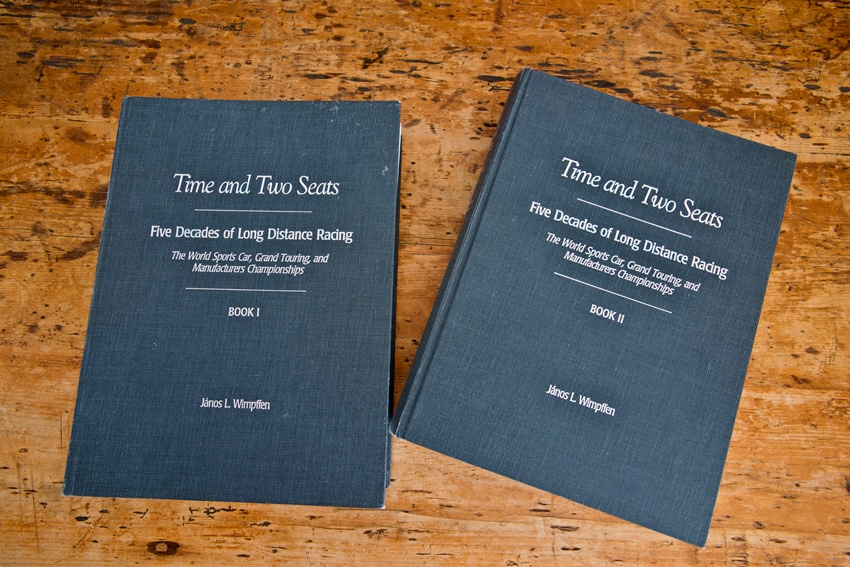With this November issue, book reviews return to the magazine. These listings appear in this issue to give those who love you perhaps enough time to source, secure, and gift wrap them for you in time for the December holidays.
You’ll know how much they love you if you ask for either of these first two multi-volume sets – and you receive them: you are well loved and your hobby is incredibly tolerated.
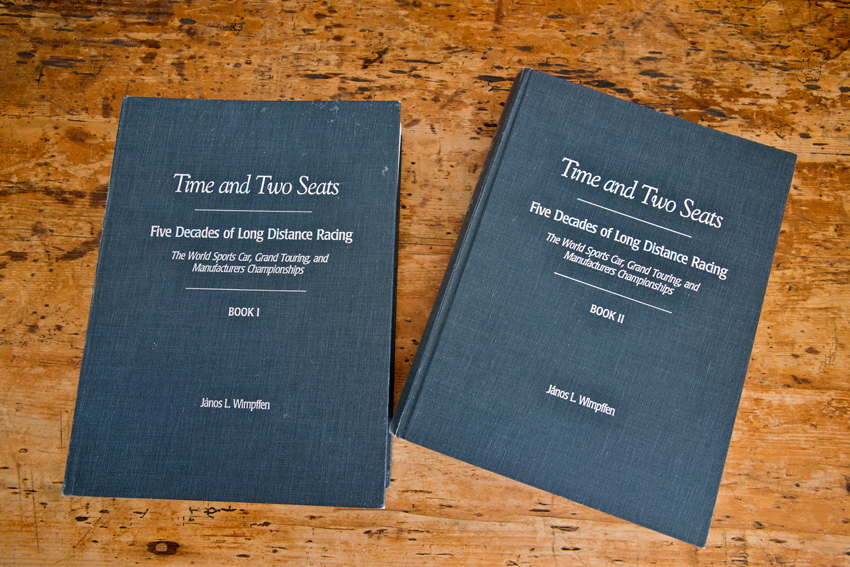
Time and Two Seats; Five Decades of Long Distance Racing – The Worlds Sport Car, Grand Touring, and Manufacturers Championships
János Wimpffen. 1999 Motorsports Research Group, Redmond, Washington. Two volumes. 2,255 pages. (ISBN 0-967-22522-0-5) Out of Print.
Porsche’s Museum co-director and head of Archives Dieter Landenberger has called these two volumes his single most important reference resource. Beginning with the 1953 racing season, and concluding at the end of 1998, Wimpffen’s books are not only useful – he has encyclopedic listings (the 1953 Mille Miglia, for example, started with 578 entrants and Wimpffen lists them all, with their overall finish, car number, drivers, car, time, an explanation if they did not finish, their group, their class, and their class finish, spanning eight pages). These books also are enjoyable for his engaging writing style in which he provides vivid narrative to enliven the lists. There are photos from many of the events he covers. Each year finishes with a summary. His year-end wrap-ups list not only marques championship points but also those for drivers as well. Some individuals have found errors – not surprising in a work encompassing 2,255 pages. And for a number of years a rumor floated that Wimpffen was going to update (and correct) these two volumes, though there’s no confirmation yet.
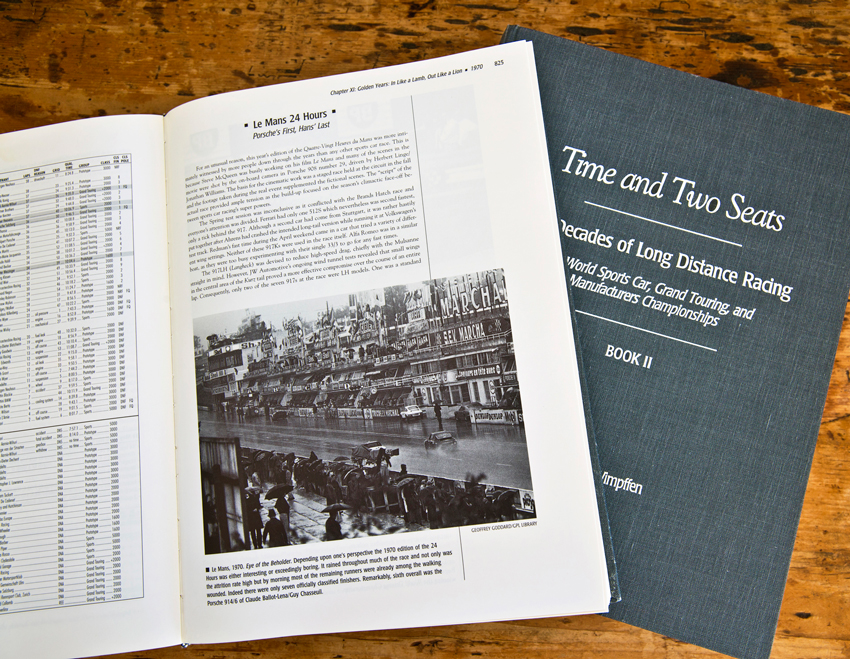
These books are not small and, because they’re long out of print, they certainly are not cheap. But if your passion is endurance racing (time) in sports cars and prototypes (two seats), this two-volume set with give you plenty of time in your favorite monoposto arm chair to remind yourself in luminous detail why racing fascinates you.
Search for this on www.Alibris.com or www.AbeBooks.com.
If racing is less enticing to you than series production road-going automobiles, then this next three-volume set may suit you perfectly:
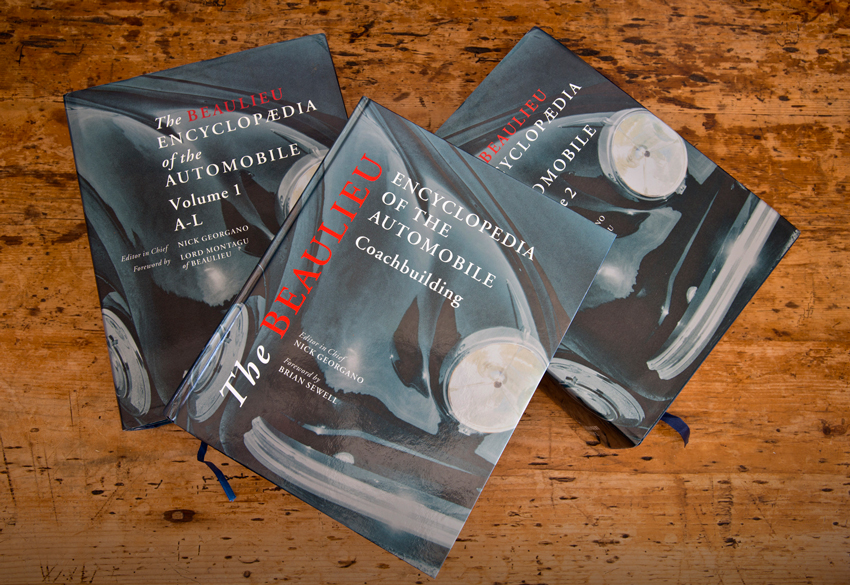
The Beaulieu Encyclopedia of the Automobile
Editor in Chief Nick Georgano. 2000. The Stationery Office. London. (Volume 1, A-L; Volume 2, M-Z, 1,792 pages plus glossaries; ISBN 011 7023191)
The Beaulieu Encyclopedia of the Automobile Coachbuilding
Editor in Chief, also Georgano. 2001 Fitzroy Dearborn, Chicago. 390p. (1-57958-367-9) Out of Print.
As an auto enthusiast, you surely recognize the car-manufacturing firm Benz. Karl Benz is credited with producing the first gasoline-engine car – albeit it a tricycle – to run successfully, in 1885. Thirty-one years later, in 1926 Benz merged with Daimler, creating the modern-day Mercedes-Benz Company.
But have you heard of Benz Söhne? This was the firm that Karl’s sons Eugen and Richard established in 1906, after their relationship with their father frayed for the last time. This company remains in business today, providing a number of components for Daimler-Benz.
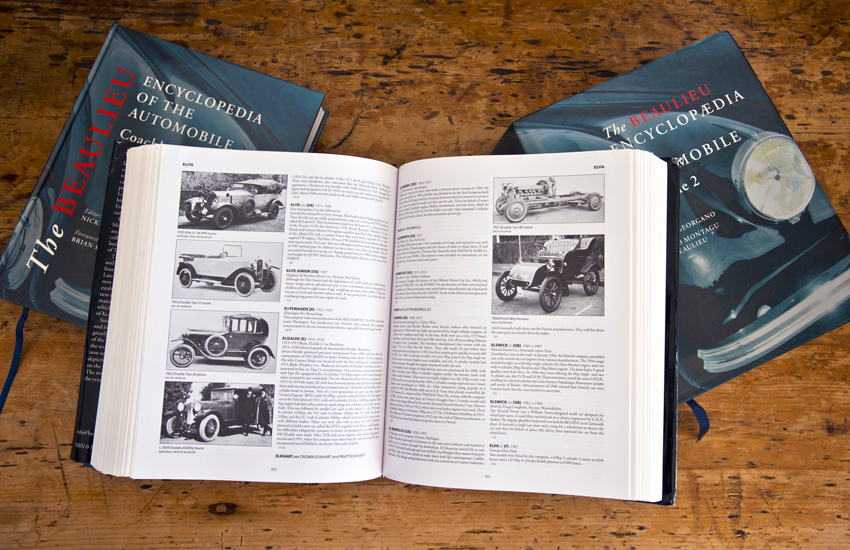
Of course you know Porsche but do you know about P.R.O.S.C.A? This was a one-year wonder – 1966 – based on “a radically modified Porsche 914 with handsome race-styled body panels and a lower profile due to the removal of the original roof. The P.R.O.S.C.A. company, of Santa Clarita, CA, offered the car in kit form or assembled, using 911 suspension and engines ranging from Mazda rotaries to V-6 or V-8 engines from Ford or Porsche flat-sixes. Their single model was called the P.R.O.S.C.A. 940.
Volkswagen and Volvo are well known but what about the Swedish Vabis (1898 to 1911) or the German front-wheel drive Voran (from 1926 to 1928 in Berlin)?
D’Ieteren Frères in Belgium produced bodies for 356 Convertible Ds. But they also assembled sumptuous bodywork on Duesenbergs, Bugattis, Hudsons, and Mercedes. Ernst and Fritz Beutler near Bern, Switzerland, manufactured the first cabriolets for Porsche as well as a series of custom bodies on 356 platforms. But they also did a Packard, and a number of bodies on Jaguar and BMW chassis. Nuccio Bertone in Turin, Italy, did a one-off convertible prototype for Johnny von Neumann as a 911 concept, but Bertone and his studio also used very similar forms on the production Fiat 850 cabrio. Bertone did aerodynamic studies for Alfa Romeo and design concepts for Ferrari, Maserati, and Lamborghini.
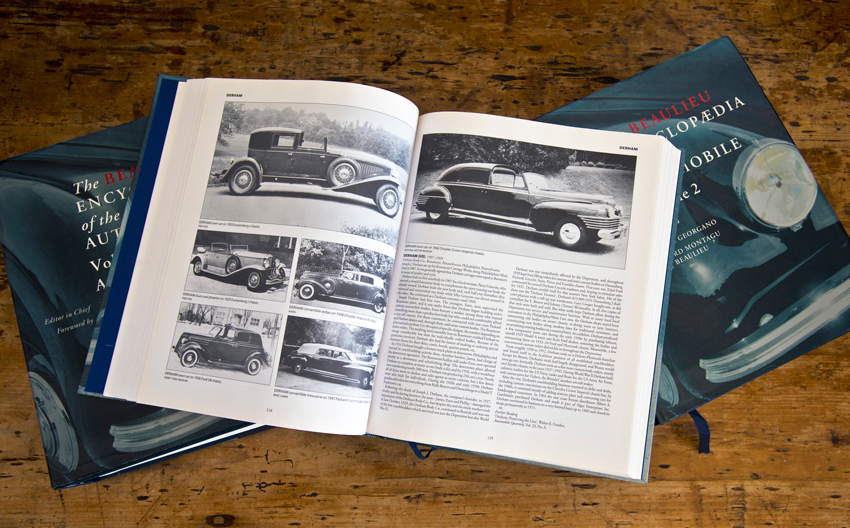
The three volumes of the Beaulieu Encyclopedia are just slightly less readable, but are no less fascinating, than Wimpffen’s Time and Two Seats. They are after all encyclopedia entries. If you are interested in American and European Brass Era and Classic cars and those before and more modern, the Beaulieu books will answer hundreds of questions. Most, though not all, entries have at least one illustration; the majors are well covered. There are glossaries at the back of each volume; the one that completes the Coachbuilding book explains the difference between a cabriolet, a convertible, a drophead, a roadster, a speedster, and a spider.
Regrettably, these three volumes also are out of print. Copies of The Beaulieu Encyclopedia, with or without the coachbuilding volume, and of Wimpffen’s Time and Two Seats do appear occasionally on Alibris, or through collector booksellers associated with automotive subjects. T. E. Warth Esq. in Wisconsin sometimes locates these, and they sometimes show up in listings from English booksellers. Be aware, however, that shipment by sea can take three months and is iffy, and charges for shipment by air can seem as though you are buying these very heavy books twice.
Search for this on www.Alibris.com or www.AbeBooks.com.
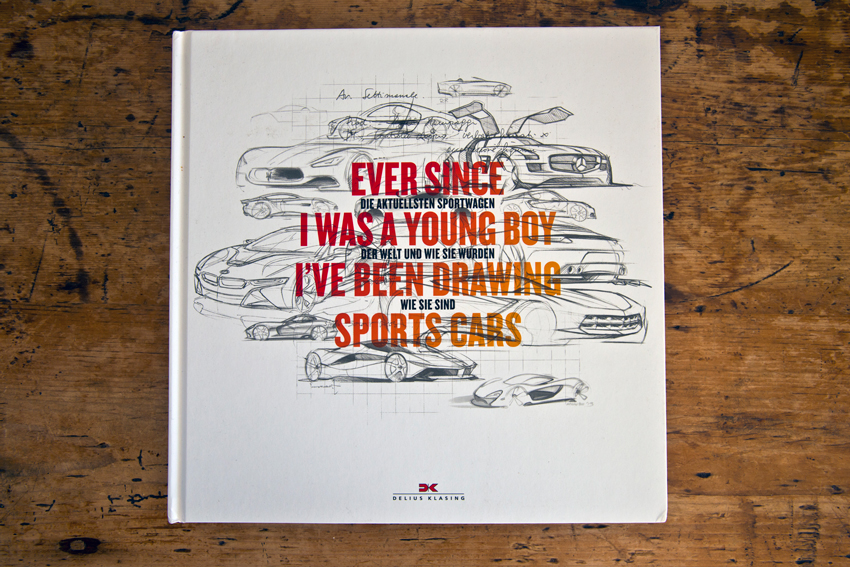
Ever Since I Was a Young Boy I’ve Been Drawing Sports Cars
Bart Lenaerts. 2014 Delius Klasing Verlag. 252p. (ISBN 978-3-7688-3872-6) German text.
How’s Your German? Thanks to Google Translate, if you have the patience, you can keystroke your way through this fascinating book. This is a second edition; the first, from 2012, did not concentrate on sports cars, and so this may be more interesting to Porsche owners and enthusiasts. This one covers design of the 991 and the 918, with comments from design chief Michael Mauer about the work of 991 stylist Peter Varga, and interiors chief Thorsten Klein. Even if you do not read German, the sketches and photos are worth the price.
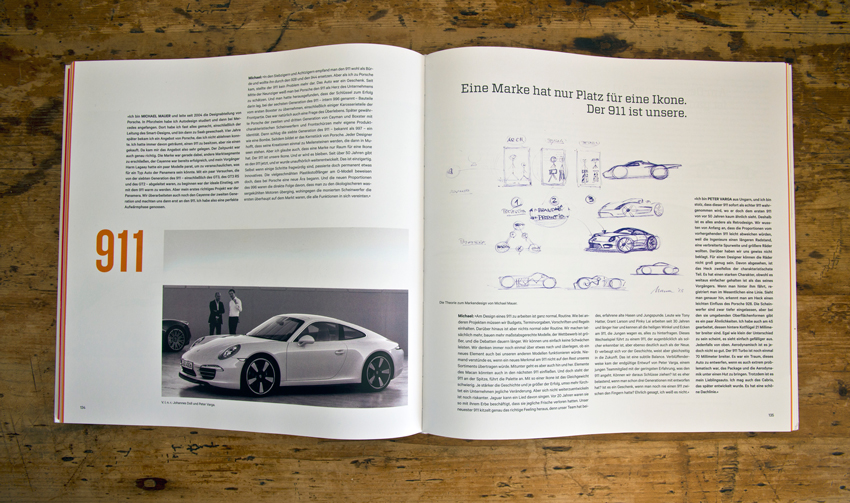
The book includes not just these two Porsche models but also the BMW i8, Corvette C7, Ferrari’s LaFerrari, the Bugatti Veyron, Audi R8, Lamborghini Huracán, Jaguar F type, and a half a dozen others.
Find this book at: www.Amazon.com.
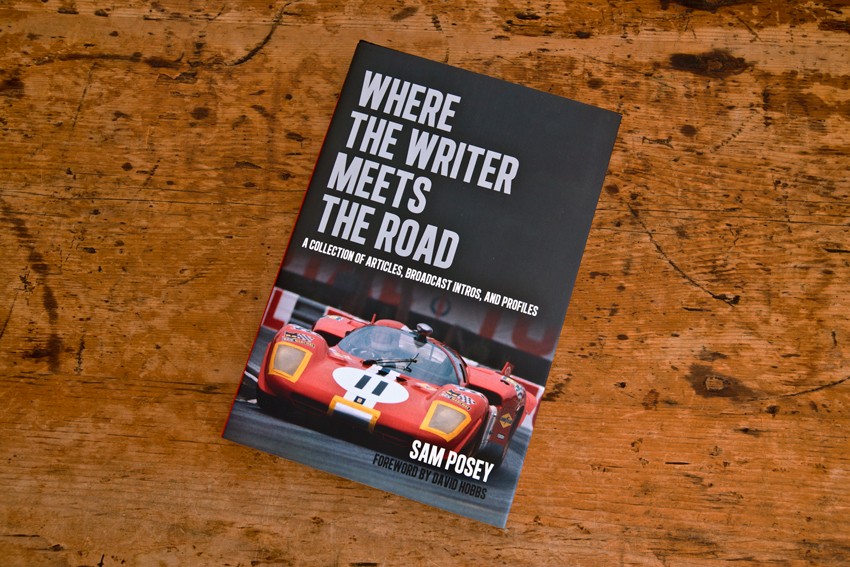
Where the Writer Meets the Road – A Collection of Articles, Broadcast Intros, and Profiles
Sam Posey. 2015 David Bull Publishing. 192p. (ISBN: 978-1935-007272)
Road & Track magazine had a knack for attracting evocative, classy writers with broad experience, vivid vocabularies, and seductive style. From staff writers Henry Manney III and Peter Egan to occasional contributors/full-time racers Rob Walker, Phil Hill, and, in this instance, Sam Posey, the words that have emerged prompted thousands of readers to close their office doors – or close out their wives and girlfriends – when the latest editions arrived.
Where the Writer Meets the Road is the latest edition from Sam. And it is a page-turner delight. His tale of racing the Cooke/Woods Lola T600 – “Fast Company” – with his friend Brian Redman at Road America reads like a thriller with a surprise ending. His profile of Mark Donohue – “Magnificent Obsession” – is insightful and elegantly and sensitively written. Posey’s career as a racer was as successful as his time as ABC’s “color commentator,” providing his “romantic, somewhat abstract view of racing” in contrast to fellow racer/commentator Bobby Unser’s “gritty, down-to-earth quality.” His chapter “Glimpses from the Booth” relate his experiences as part of the broadcast team’s coverage of the 1991 Indy 500, A. J. Foyt’s retirement race and Rick Mear’s fourth win. In contrast to the frantic pace of nearly 3,000 video cuts, Posey’s narrative treats the Indy week with the same brilliantly-measured pace that it takes to win an endurance race like Indy. His second-to-final piece – “The Loyal Opposition” – deals with his mixed emotions about Porsche’s racing and road cars. He called himself “a dissident voice in an issue celebrating Porsche’s 50th anniversary.” Then, while reckoning with the legacy of 911 body forms, he saw something: “Suddenly this car made other manufactures seem to be lurching from one style to another in search of something Porsche already had, a kind of gravitas that only time (and a few 917s) can give you.” The conclusion he draws from here is perfect, precise Posey.
Find this book at www.BullPublishing.com or at www.Amazon.com.
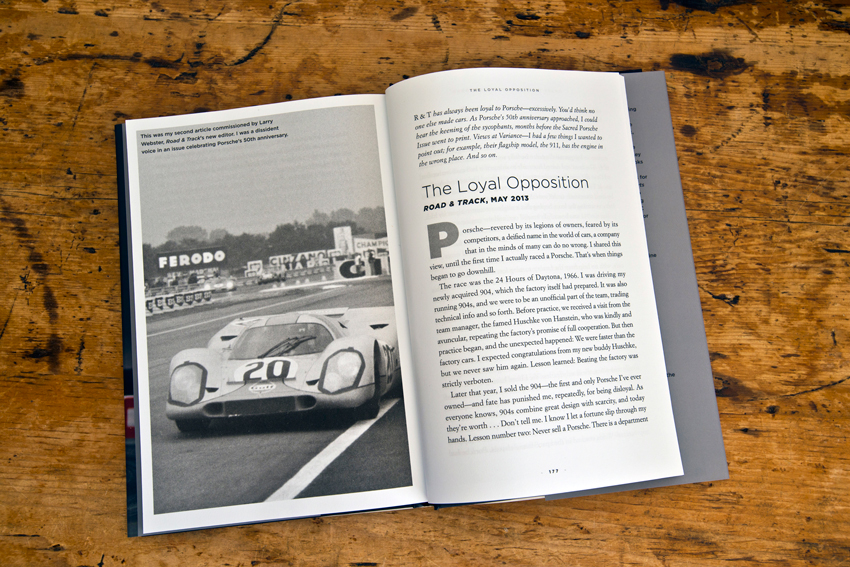
Great Cars 2 Porsche 917 – The Autobiography of 917-023
Ian Wagstaff. 2015 Porter Press International. ISBN: 978-1-907085-21-5. 320p

The 917-023 “biography” is the second in a series called The Great Cars. The first profiled a Jaguar lightweight E-type. Coming in the series are books on a Ferrari 250 GT short wheelbase coupe, a Jaguar D-type, a Ferrari 250GTO, and a Maserati 250F. The premise is simple, to treat this as a history of a single particular and unique car, like a human biography, while putting it in the context of those who lived and worked around it. In that way, this book brings out quite a few surprises. In some instances these revelations can be unearthed from other archival print sources, though the legwork to do it would take years. Wagstaff did some of that but he also took things the better, more fascinating way by interviewing each of the surviving drivers who piloted 917-023 at one time or another, along with crew and engineers, as well as a number of folks who raced against them.
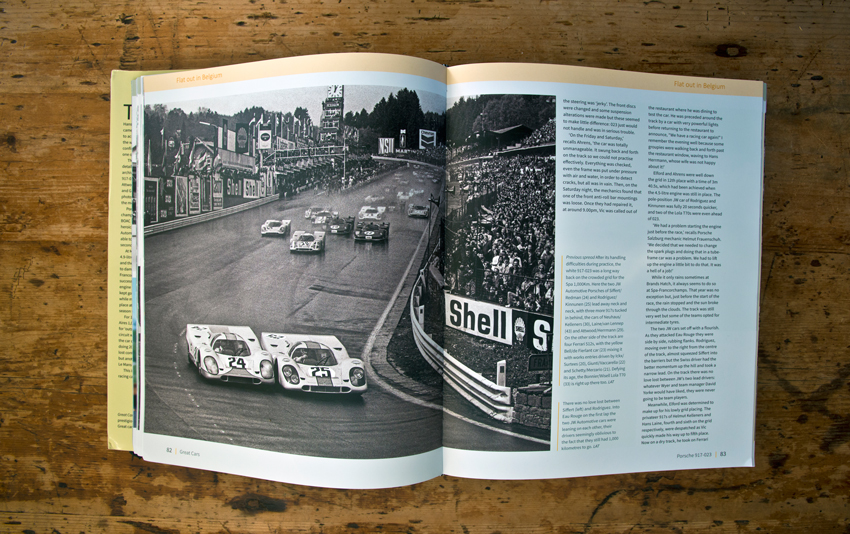
Most enthusiasts tend to think of this 917 as famous for a single accomplishment – giving Porsche its first overall victory at Le Mans, in 1970, with driving duties shared by hometown hero Hans Herrmann and Porsche-regular Richard Attwood. In fact, as Wagstaff reports, chassis 023 competed six other times and in each of those, “Quick Vic” Elford showed the world what a 917 could do in fearless hands. It is some of those races that make the book a fast fascinating read. It is however the recounting of “The Famous Win,” as the chapter title calls it, that is where Wagstaff and his drivers are at their most compelling. Attwood had considerable experience at Le Mans which Herrmann did not. They were in a car with a 4.5-liter engine while the other 917s ran 4.9s. They had a four-speed gearbox and had been ordered to not use first, so speeds from 20 miles-per-hour up to more than 220 came in three gears. There were repeated heavy rains that sent the cars aquaplaning at 220 miles per hour. There were ignition problems, and some hints of team orders manipulating finishing order. For Herrmann it was a lifetime’s dream (he had finished 2nd in 1969 by just 20 meters). He retired from racing immediately after this race. Attwood, fiercely ill with the mumps during the entire drive, was essentially numb at the finish and he admitted he didn’t realize his accomplishment for nearly two decades: “Somebody introduced me as ‘the first person to win Le Mans for Porsche.’ I had never thought of it like that.”
There is much more to this book, including fabulous photos, some familiar, some quite the opposite. If you enjoy very well told stories of individuals accomplishing extraordinary things, this book will thoroughly engage you. It continues the “biography” of the car through to the present day.
Find it at www.Amazon.com.

